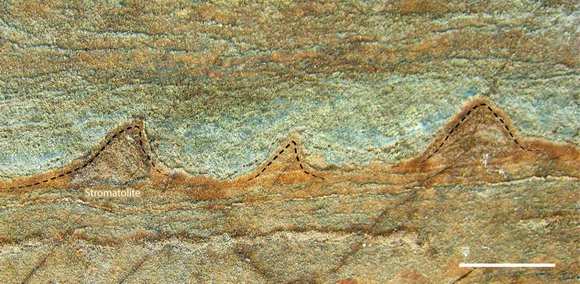The researchers believe that the structures in the rocks are stromatolites: layered formations produced by microbes. They fossilise easily and thus often play a role in research into the oldest signs of life on Earth. Today, stromatolites can still be found in very salty lagoons such as Shark Bay in Australia. The newly discovered fossils are 220 million years older than previously discovered stromatolites in Western Australia, which were ‘only’ 3.5 billion years old.

Pointed stromatolites dating from 3.7 billion years ago shown in the rocks of the Isua Greenstone Belt, Greenland. According to the researchers, this is the oldest physical evidence of life on our planet. Scale bar equals four centimeters. Photo: Allen Nutman.
Thin layers
The research team discovered the stromatolites in the rocks of the Isua Greenstone Belt in the south-west of Greenland. The newly discovered stromatolites are pointed structures of 1 to 4 centimetres in height. If one looks closely, the layered structure can clearly be seen. The thin layers are produced by microbial communities of algae or bacteria, which deposit sediment or carbonate from the surrounding water. In this way the stromatolite grows layer by thin layer.
Metamorphic
But there is a catch to the story: the Isua rocks from Greenland are metamorphic. During their formation they were repeatedly exposed to intense heat and pressure – forces that often seriously deform rocks – so it is remarkable that the stromatolites have been preserved so well. And thus not everyone is convinced about the discovery. Robert Riding, professor at the University of Tennessee in the United States, writes in The Guardian that the newly discovered structures are not sufficiently well-preserved to say with complete certainty that they are stromatolites. According to Riding, the forms could also have been shaped by tectonic processes in the area.
Life on other planets?
If the newly discovered structures are indeed stromatolites, then they not only change our understanding of the earliest forms of life on Earth, but also of that on other planets. Clark Friend, an independent researcher and co-author of the study, writes in The Guardian: “If we already had life on Earth 3,700 million (3.7 billion) years ago, then maybe there was already life on other planets too? Mars was still wet 3,700 million years ago.” Perhaps the shallow lagoons of Mars were already teeming with life at that time.
Source:
Nature
Tree of life
Would you like to know more about the oldest life forms on Earth? Discover it in the tree of life in Micropia.
